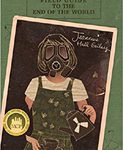 Jeannine Hall Gailey
Jeannine Hall Gailey
Field Guide to the End of the World
Moon City Press
Reviewer: Stephanie Chan
There is a deeply empathetic tone throughout Jeannine Hall Gailey’s Field Guide to the End of the World. The book is divided into sections—“Disaster Studies,” “Cultural Anthropology,” “Hard Science,” “A Primer for Your Personal Genome Project,” “End Times Eschatology ”—each tackling the concept of apocalypse in a deeply personal way—flirting with science fiction as metaphor, reveling in pop culture, and casting an occasionally romantic light on what it means for something to end. Gailey also never forgets that with each end, there is also a beginning.
Field Guide bears a similarity at times to Mr. Burns, a Post-Electric Play by Anne Washburn, a play that also explores the idea of pop culture as artifact after the downfall of civilization. Mr. Burns tracks the immortalization of an episode of The Simpsons, “Cape Feare,” in a kind of post-apocalyptic game of telephone. The story warps with each retelling, becoming more and more mythic in nature until it’s no longer just a story but a full-blown pageant, a reminder of a culture lost to time.
While pop culture lives on only as a vague memory in Mr. Burns, the poems in Field Guide are clear-eyed with details. The nameless characters write letters to John Cusack; they seek refuge with Ina Garten; they ponder the bitter plights of Wile E. Coyote and Poison Ivy.
At the end of the world, pop-culture icons act as old friends and confidantes, earning a kind of permanence in a life with no certainties. These references enable the characters to discuss their new realities using a familiar grammar, re-contextualizing a dystopian future and lending some air of normalcy to an extreme situation.
“Post-Apocalypse Postcard (with Anthropologie Catalog)” wistfully recalls the girls in fashion catalogs wearing “$300 faux-metal tiaras” and holding “$1,000 hand-crafted tree toppers.” Though she never was one of those girls in her old life, the narrator notes that at the end of the world: “And now here, this desert landscape lends itself to exactly that—emaciated and pale under tents, we stand and wait for the sun with expressions hinting of some future pleasure.”
Similarly, “Post-Apocalypse Postcard (with HGTV Magazine)” summons the specters of neat houses and real estate bargain hunting. Real estate means something very different after the apocalypse: “Everyone fled the cities; now we look for country charm, for provisions, for a secret bunker of canned food and Cipro.”
And for more of that “country charm,” “Martha Stewart’s Guide to Apocalypse Living” outlines neatly everything you need to do to survive with style. In the voice of Martha, it notes, “Survival skills are just like hostess skills: a little preparation, a little spying with the drones, a little determined defense-driven hedging of the grounds.” Her catchphrase is clutched tight like a ward against disaster: “If your water isn’t as clear as it should be, use up those charcoal filters first, but after, try a solid iodine tablet in your home-dug well. In these times, it’s a good thing.”
Amid the character studies and invocations of icons like Carl Sagan and Hedy Lamarr, the poems barter and ponder the lifestyles sold in glossy magazines and on slick TV shows. Punctuated with a dry sense of humor, there is an achingly lonely quality to many of the poems as the characters examine their dreams, their pasts, their imagined futures. They fantasize about the lives they were promised—by celebrities, by loved ones, by modern comforts. “Post-Apocalypse Postcard from an American Girl” find its narrator striving to reach those promises, to “do more than survive”: “Beneath the wild eyes of her faded toy horses, the blank gray faces of dead television sets, she dreams once more of a little more life, somewhere else.”
There is the sense that the end of the world comes not only at a global expense, but a personal one as well. Postcards and missives to absent lovers are scattered through the collection. Often from a first-person perspective, they examine the apocalypse without and within. “A Narcissist’s Apocalypse” rages against the extinguishing of the self: “If this is the end, let me tell the story. Let me write it in stone, send it out into the universe on a rocket.” The poem demands to be heard and its narrator refuses to be reduced to a statistic.
“Introduction to Hot Air Ballooning with Ruby Slippers” reimagines The Wizard of Oz as a coming-of-age story. Part III of the poem is titled “If I Stayed in Kansas, I Knew My Future,” and so Dorothy instead chooses to end her old world in pursuit of another: “So I ran after the man promising so much more, mystical cures and balloon rides. You won’t see me again in Kansas, not middle-aged before my time, rough-skinned, dirt in my throat and bitter on the tongue.”
Ultimately, as the title suggests, Field Guide to the End of the World is a collection of ways to cope and continue.
In “The Last Love Poem,” the poem is defiant in the necessity of its beauty and resilience: “Do you see this as a rebellion? That after all this, the poet clings, stubborn, to romance, to the idea that somehow a small connection, a tiny universe of fire and friction, might be preserved?”
Even when describing the ravaged landscape, there’s a sense of optimism and a strong call for self-determinism. The sense of self is exalted, and survival against the odds is never ruled out. This is most clear in the epilogue, the last of the collection.
“I want to tell you a story about how we survived the end of the world,” the poem begins. This comes at the end of a section named “End Times Eschatology,” eschatology being defined as “a belief concerning death, the end of the world, or the ultimate destiny of humankind.” And what, according to Field Guide to the End of the World, is the ultimate destiny of humankind? “Epilogue: A Story for After” declares, “We are miraculous.”
Though the pop culture references could have easily been hackneyed, Gailey wields them with grace. She makes the end of the world strangely relatable, filled with details of normalcy that have been flipped on their heads. Field Guide to the End of the World feels very much like a collection of postcards, poems sent from a series of desolate vacation spots, each inscribed “Wish you were here”—with romantic nostalgia for a future that may or may not come to be.

